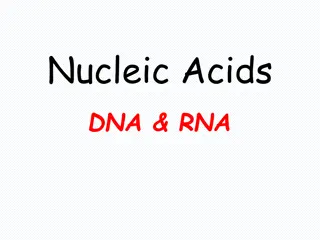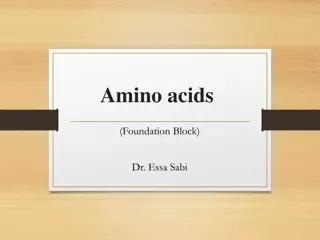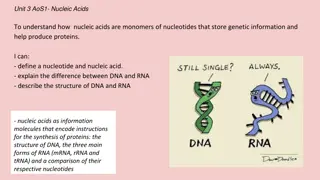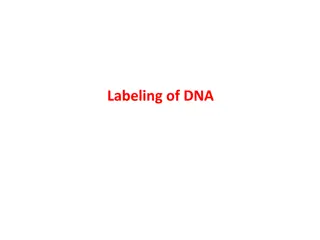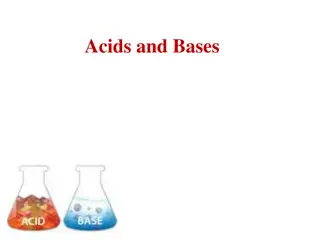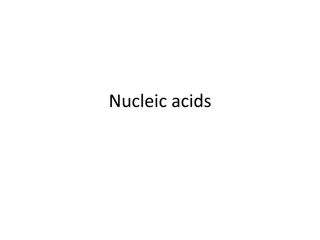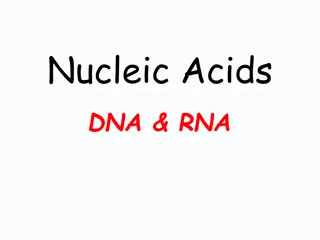Nucleic Acids Overview
Delve into the intricate world of nucleic acids with a focus on DNA and RNA structures, DNA replication, RNA transcription, protein biosynthesis, cancer/chemotherapy, genetic engineering, and more. Explore the structures of bases, sugars, nucleosides, nucleotides, and parts of nucleotides, along wit
8 views • 58 slides
Understanding Nucleotide Biosynthesis and Nucleic Acids
Exploring the biosynthesis of purines and pyrimidines, essential components for DNA and RNA structures. Delve into the world of pyrimidines, purines, nucleosides, nucleotides, and adenosine derivatives like AMP, ADP, ATP, and cAMP, crucial for various biological processes. Unravel the significance o
5 views • 44 slides
Understanding Animal Genetics: A Comprehensive Overview
Animal genetics is the study of heredity, inheritance of traits from parents to offspring, genetic material like DNA, chromosomes, genes, alleles, and nucleotides. It involves the understanding of chromosomes in different livestock species, DNA as the carrier of genetic information, genes as units o
0 views • 67 slides
Understanding Acids, Bases, and Buffers in Medical Biochemistry
Biologically important molecules, such as acids and bases, have significant roles in metabolism. Strong acids like hydrochloric acid ionize completely, while weak acids and bases play crucial regulatory roles. The Bronsted-Lowry theory defines acids as proton donors and bases as proton acceptors. Eq
0 views • 29 slides
Understanding Hard and Soft Acids and Bases (HSAB Principles) by Dr. Gurpreet Kaur
Delve into the world of Hard and Soft Acids and Bases (HSAB) with Dr. Gurpreet Kaur as she explains the characteristics of hard and soft acids, Pearson's HSAB principle, applications such as predictions of coordination in complexes, poisonings of metal catalysts, and the classification of acids and
2 views • 17 slides
Understanding Amino Acids: Qualitative Tests and Properties
Amino acids play a crucial role as building blocks of proteins and can be converted into specialized products. There are 20 common L-α-amino acids found in mammalian proteins, each with a unique structure and classification based on their side chain properties. Amino acids exhibit optical activity,
1 views • 34 slides
Understanding Acids, Bases, and Neutrals in Natural Sciences Grade 7
Acids, bases, and neutrals are vital substances found in various settings like factories and laboratories. They exhibit distinct properties, with acids feeling rough, being corrosive, and containing hydrogen ions, while bases feel slippery, taste bitter, and contain hydroxide ions. While acids like
0 views • 15 slides
Understanding Acids and Bases: Definitions and Behavior
Explore the definitions of acids and bases according to Arrhenius and Brønsted-Lowry theories, their behavior at a particulate level, and the differences between strong and weak acids and bases. Learn how to define, identify, and understand the properties of acids and bases through practical exampl
0 views • 12 slides
Overview of Nucleic Acids in School of Pharmaceutical Sciences
Pratima Katiyar from the School of Pharmaceutical Sciences provides an introduction to nucleic acids in a comprehensive presentation. Covering various aspects including structures, functions, and importance, the slides offer valuable information for students and researchers alike. References to key
0 views • 19 slides
Amino Acid: Structure and Classification Overview
Amino acids are essential building blocks of proteins, with only 20 out of the 300 occurring in nature being used for protein synthesis. The structure of amino acids consists of four groups attached to a central carbon atom. At physiological pH, these groups can ionize, forming zwitterions. Amino ac
0 views • 24 slides
Understanding the Structure and Role of Amino Acids in Proteins
Amino acids are building blocks of proteins, with distinct structures and properties. There are 20 common amino acids found in mammalian proteins, each with a carboxyl group, an amino group, and a unique side chain. The side chains determine the role of an amino acid in a protein, classified as nonp
8 views • 11 slides
Exploring Nucleic Acids: DNA and RNA Structure and Function
Delve into the world of nucleic acids with a focus on DNA and RNA molecules. Discover the fundamental building blocks, such as nucleotides, and the role they play in genetic information storage and cell function. Learn about the unique characteristics of DNA like its double-helix structure and the s
0 views • 26 slides
Understanding Fatty Acids and Derived Lipids
Explore the world of fatty acids and derived lipids through detailed images and descriptions. Learn about the chemical structure, composition, and various types of fatty acids found in the human body. Discover how fatty acids are essential components of lipid forms and play a crucial role in biologi
0 views • 154 slides
Understanding Lipids: Properties, Functions, and Structure
Lipids are diverse organic compounds vital for metabolism and cell functions. They are insoluble in water, serve as energy sources, aid in hormone synthesis, and form cell membranes. Fatty acids, the building blocks of lipids, provide fuel for the body. Saturated fatty acids have high melting points
0 views • 44 slides
Understanding Amino Acids: Structure, Classification, and Properties
Amino acids are crucial chemical units that form proteins and play essential roles in the body. They consist of a carboxyl group and an amino group, serving as building blocks and metabolic intermediates. This article covers the general structure, zwitterions, isoelectric point, pK values, and class
0 views • 26 slides
Understanding Acids and Bases in Chemistry
Acids donate protons, while bases accept them. Strong acids ionize completely while weak acids only partially ionize, resulting in a Ka value less than one. Water, being amphoteric, can both donate and accept protons. The ionization of water leads to a constant Kw value of 10^-14. Explore the ioniza
0 views • 15 slides
Understanding Macromolecules in Forensics and Biology
All living organisms contain essential organic macromolecules - lipids, proteins, carbohydrates, and nucleic acids - composed of carbon, hydrogen, oxygen, and other elements. These macromolecules serve vital functions in cellular processes and structure, with carbohydrates providing energy sources a
0 views • 19 slides
Qualitative Tests of Proteins & Amino Acids: Overview and Analysis
In this lab, you will delve into the qualitative tests for proteins and amino acids, understanding their structures, classifications, and importance in food and human nutrition. The tests include solubility tests and identification tests for both amino acids and proteins, revealing their presence an
0 views • 13 slides
Qualitative Tests of Proteins & Amino Acids - Lab Analysis Overview
This lab analysis covers qualitative tests for proteins and amino acids, including solubility tests and identification tests for amino acids and proteins. Specific tests like Ninhydrin test for -L amino acids, Xanthoproteic test for aromatic amino acids, and lead sulfite test for sulfhydryl group de
0 views • 13 slides
Comparison of Aliphatic and Aromatic Carboxylic Acids in Chemical Properties
The article explores the differences between aliphatic and aromatic carboxylic acids, detailing their properties, common uses in food and cosmetics, as well as their reactions in ignition tests. It discusses the appearance changes and odor variations upon ignition, along with the distinctive color f
0 views • 14 slides
Gel Electrophoresis for Assessing Nucleic Acid Quality
Gel electrophoresis is a crucial technique for assessing the quality and yield of nucleic acids such as DNA and RNA. It separates DNA fragments based on size, allowing researchers to determine the integrity of the nucleic acids. By running a small amount of sample on a gel and using DNA-binding dyes
0 views • 9 slides
Understanding Nucleic Acids and RNA Molecules
Nucleic acids are linear polymers composed of nucleotides, with DNA and RNA being the main types. RNA consists of messenger RNA (mRNA), transfer RNA (tRNA), and ribosomal RNA (rRNA), each playing a crucial role in protein synthesis. mRNA carries genetic information from DNA to ribosomes, tRNA transf
0 views • 8 slides
Understanding Nucleic Acids: DNA, RNA, and Nucleotides
Nucleic acids are essential molecules that store genetic information and aid in protein production. This content delves into the monomeric structure of nucleotides, the differences between DNA and RNA, the unique characteristics of DNA's double helix structure versus RNA's single-stranded form, and
0 views • 11 slides
Understanding Nucleic Acids: DNA, RNA, and Nucleotides
Nucleic acids, essential for all organisms, store genetic information as long polymer chains of nucleotides. Nucleosides contain bases and sugars, while nucleotides include a phosphate. Purines and pyrimidines are the aromatic bases in nucleotides, with DNA having A, G, C, T and RNA having A, G, C,
0 views • 10 slides
Understanding Acids and Bases in Chemistry
Acids and bases play essential roles in chemistry, where they release hydrogen ions or hydroxide ions when mixed with water. Acids, like vinegar and lemon juice, are corrosive and can cause chemical burns. On the other hand, bases, such as bleach and dish soap, contain the hydroxide group in their f
0 views • 19 slides
Understanding Amino Acids: Structure, Types, and Importance
Amino acids are essential organic molecules that serve as the building blocks of proteins. They contain unique chemical groups and play crucial roles in various bodily functions. This article discusses the structure of amino acids, their different types (D and L), and highlights their importance in
0 views • 11 slides
Understanding Conjugate Acids and Bases in Chemistry
Explore the concept of conjugate acids and bases in chemistry through definitions, reactions, and examples. Learn how to identify strong and weak acids/bases based on their conjugates and understand the behavior of acids/bases in reverse reactions. Discover the significance of conjugate acids/bases
0 views • 22 slides
Understanding pH Calculations for Acids and Bases in Water
Acids and bases play crucial roles in chemical reactions by involving the transfer of protons. This lecture explains the definitions of acids and bases, general acid-base reactions in water, and how the pH scale is used to measure the acidity or basicity of a solution. It covers how acids and bases
0 views • 42 slides
Understanding Nucleic Acids: The Building Blocks of Life
Nucleic acids, such as DNA and RNA, play a crucial role in storing and transmitting genetic information in living organisms. These biopolymers are composed of nucleotides, each consisting of a sugar, phosphate group, and nitrogenous base. DNA and RNA differ in sugar composition and nucleobases. Nucl
0 views • 14 slides
The Role of DNA in Cellular Information Storage
Nucleic acids like DNA and RNA play critical roles in storing cellular information in the form of codes, enabling the formation of an organism's enzymes and structural proteins. Nucleotides, the building blocks of nucleic acids, consist of a simple sugar, a phosphate group, and a nitrogenous base. B
0 views • 21 slides
Understanding Nucleic Acid Labeling and Detection in Molecular Biology
Nucleic acid labeling and detection play crucial roles in molecular biology, where hybridization helps identify complementary DNA or RNA sequences. Techniques like using labeled probes are essential for precise detection in complex nucleic acid mixtures. Understanding radioactive activity units and
0 views • 22 slides
Discovering the Genetic Material: From Nucleic Acids to DNA Transformation
Essential discoveries in genetics, from the recognition of nucleic acids as genetic material to the transformation experiments proving DNA's role. The journey encompasses the chemistry of DNA, the debunking of the tetranucleotide hypothesis, bacterial transformation studies, and the groundbreaking i
0 views • 23 slides
Mapping QTL and Selection of Soybean Lines with High Essential Amino Acids
Soybean (Glycine max L.) plays a crucial role as a crop in North Carolina, especially for its essential amino acids content critical for human and animal nutrition. This study aims to identify quantitative trait loci (QTL) for essential amino acids in soybean seeds using a genetic map from the Forre
0 views • 4 slides
Understanding Acids and Bases: Ionization and Properties
Acids donate protons while bases accept them. Strong acids and bases ionize completely, while weak acids ionize partially. Water is amphoteric, capable of both accepting and donating protons. The equilibrium constant Kw for water is 10^-14. Understanding the ionization of weak acids and weak bases h
0 views • 15 slides
Understanding Acids and Bases in Chemistry: Key Concepts and Terminology
This chapter delves into the fundamental concepts of acids and bases in chemistry, covering Arrhenius, Bronsted-Lowry, and Lewis definitions. It discusses conjugate acids and bases, acid dissociation, dissociation of strong and weak acids, and the differences between strong and weak acids/bases. The
0 views • 41 slides
Understanding Nucleic Acids: Key Properties and Functions
Nucleic acids, including DNA and RNA, are fundamental molecules in all life forms, serving as hereditary determinants in cells. They are composed of nucleotide units, each containing a sugar, amine base, and phosphate group. The structure of DNA, with its double-stranded helix model, reveals specifi
0 views • 15 slides
Exploring the World of Nucleotides and Nucleic Acids
Discover the fascinating realm of nucleotides and nucleic acids through characteristic bases, pentoses, tautomeric forms of common pyrimidine and purine bases, electron-rich nature, UV absorption spectra, furanose structures, major and minor bases, nucleosides, and phosphodiester bonds linking succe
0 views • 26 slides
Overview of Different Types of Nucleic Acids in Viruses
Explore the diverse types of nucleic acids found in viruses, including ssDNA, dsDNA, ssRNA, dsRNA, single-stranded cyclic DNA, double-stranded cyclic DNA, single-stranded cyclic RNA, and double-stranded cyclic RNA. The provided images depict the various classifications, shedding light on the genetic
0 views • 10 slides
Understanding Nucleic Acids and the Central Dogma of Molecular Biology
In molecular biology, understanding nucleic acids like DNA and RNA is crucial for comprehending the central dogma, which explains the flow of genetic information from DNA to RNA to proteins. Nucleic acids are polymers of nucleotides, composed of pentose sugar, nitrogenous bases, and phosphate groups
0 views • 18 slides
Understanding Nucleic Acids: DNA and RNA Overview
Nucleic acids, including DNA and RNA, are essential molecules storing genetic information for cellular functions. Comprised of nucleotides with nitrogenous bases, sugars, and phosphate groups, they play crucial roles in intracellular signaling, energy transfer, and genetic makeup determination. Ribo
0 views • 26 slides











